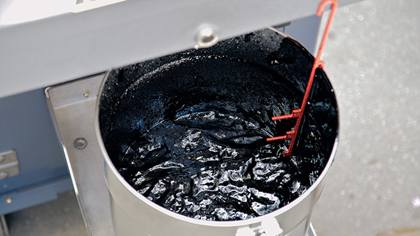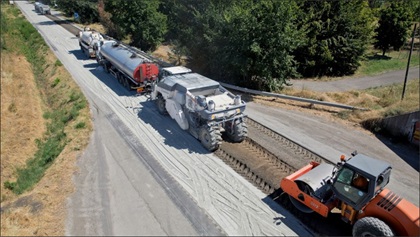Full Depth Recycling - Foamed Asphalt (FDR-FA)
In-place recycling technologies such as FDR-Foamed Asphalt (FDR-FA) can help Caltrans achieve both environmental and economic goals. By limiting landfill material, reducing truck trips and saving taxpayer dollars, consideration should be given to in-place recycling strategies when conditions are appropriate.
Full Depth Recycling-Foamed Asphalt is an on-grade method of pavement rehabilitation that consists of pulverizing the existing asphalt concrete pavement and a portion of the underlying granular base to a maximum depth of 12 inches, mixing and stabilizing the recycled section with a foamed paving-grade asphalt, grading and compacting the recycled mixture, and overlaying with a new layer of hot mix asphalt (HMA). Other materials, including aggregate base, lime, and Portland cement may be added before mixing as needed. Currently, cement is the most common chemical additive used at low percentages for early opening strength.
FDR-FA can treat most pavement distresses, which include:
- Cracking
- Rutting
- Poor ride quality
- Weathering
- Potholes
- Patches
- Shoving
- Slippage
- Delamination
- Raveling
- Bleeding
- Corrugations
Although FDR-FA will address damages in the pavement caused by moisture, FDR-FA will not solve drainage and subgrade issues and must be resolved prior to FDR-FA activities. As with conventional HMA projects, a proper site investigation is required to ensure a good structural and mix design.
Mix Design
The general procedure for FDR mix design is as follows:
- Sample surface course, base, and underlying layers of pavement
- Process old HMA to obtain RAP Combine materials and determining gradation, optimum moisture contents, sulfates, and chlorides.
- Determine maximum dry density and optimum moisture content of combined material
- Mix and compact materials at different percentages of the stabilizing agent
- Cure specimens
- Test trial specimens for Indirect Tensile Strength (IDT) to determine optimum stabilization percentage
- Establish a mix design formula
- Construct FDR pavement and adjust if necessary
Indirect Tensile Test (IDT)
After determining the foamed asphalt application rate, mixture optimum moisture content, gradation, and additive content, the mix shall be subjected to indirect tensile testing (IDT) as part of California Test Method 313. Six specimens shall be compacted and cured at 100°F for 72 hours and then cooled to room temperature. Three samples shall be tested for dry tensile strength. The other three specimens shall be tested for wet tensile strength after moisture conditioning. The FDR-foamed asphalt mix design process must comply with California Test Method 371.
Asphalt Foaming Characteristics
The asphalt foaming characteristics include the asphalt expansion ratio and the asphalt half-life, determined following California Test Method 313. The foaming characteristics are integral to FDR-FA to ensure aggregates are coated with foam to form spot welds in between aggregates. The asphalt expansion ratio is defined as the ratio between the maximum volume achieved in the foamed state and the volume of binder once the foam has completely subsided. The half-life of the foamed expansion is the time for the foamed asphalt to reduce to half of the maximum volume attained during the foaming process. The selected asphalt should be free of anti-foaming agents, such as silicones.

Figure 1. Foamed Asphalt Characteristics Tests
Application
FDR-FA is suited for all volume roadways. Before the final wearing course is constructed, vehicles must traverse an unpaved surface at reduced speed.

Figure 2. Full Depth Recycling
Special Considerations
Special considerations are required for FDR-FA operations on pavements with:
- Ambient air temperatures below 50 degrees F or the road surface is below 50 degrees F
- Treated bases or Portland Cement Concrete (PCC)
- Base or subgrade deterioration due to:
- Fatigue
- Moisture intrusion
- Other causes
- Moisture related problems cause all pavements to fail prematurely. Poor drainage should be
repaired prior to beginning FDR operations. Moisture related problems may include:- Poor drainage
- Pumping
- Saturated subgrade material
- Numerous underground utility access points
Implementation
Specifications for FDR-FA may be found in the 2018 Standard Specifications Section 30-3 Full Depth Reclamation-Foamed Asphalt.
Please forward any questions, comments, suggestions, or requests for resources to FDR@dot.ca.gov.
Resources
- Highway Design Manual: Chapter 630 Flexible Pavement
- Caltrans In-Place Recycling Manual
- DES Website
- Office of Asphalt Pavement
- Wirtgen Cold Recycling Technology Manual (external link)
- Road Resource Website (external link)
- Portland Cement Association Manual (upon request)

